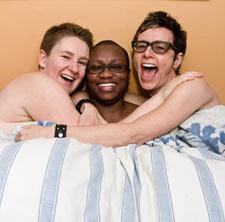
POLYANNAS. Nonmonogamy can mean more love and more sex but also more work. (Special thanks to models Parul Pandya, Jaigris Hodson & Veronika Swartz.) Credit: Peter Bevan

FAMILY VALUES. Long-term partners Tania Szablowski and Dianne Hamilton practice poly — and parent three-year-old Oscar. Credit: Oscar Szablowski
Long before The Ethical Slut was even a twinkle in its authors’ eyes I experienced my first temptation toward multiple sexual relationships.
I was sitting in the car of a handsome, playful guy I really wanted to do. But I already had a boyfriend, a serious one, who happened to be working overseas at the time. It wasn’t that I didn’t love him or didn’t want to be his girlfriend, but I also wanted to explore my desire for the guy sitting only a slim gearshift away from me.
He wanted to play too but was conflicted by my being “someone else’s girlfriend.” The phrase triggered an instinctual protest in me. As a pretty green sexual being with almost no political analysis and certainly very little relationship experience, it nevertheless felt hugely unfair that I should “belong” to someone else and consequently have my sexual activity curtailed, especially at a time in life when every single hormone has its own personal megaphone.
So I didn’t curtail my activity. My friend and I had a romp or two that turned into a summer fling and I didn’t break up with my boyfriend. But, choosing to continue in a conventional, monogamous relationship, I ended up feeling guilty and ashamed, like I’d done something terribly wrong.
Multiple sexual relationships didn’t poke up at me again until I had immersed myself in a good deal of feminist politics and was exuberantly exploring my gay sexuality. As I pulled myself free of compulsory social constructs, like a stripper peeling it off, I realized that relationships could be of many calibres. I could have sex with someone I wasn’t in love with. I could love someone and not be sexual. I developed close, important friendships that would never be trumped by a sexual act with someone else. I engaged in sex with someone else that regrettably ended a sparkling new relationship I wanted to keep.
Why did the physical, bodily activity of getting it on with another person have such priority over any other connection that people could share? Why, if you slept with someone, even once, were they suddenly supposed to be more important than anyone else in your life? Why, if you slept with someone else, did that become the most decisive thing between you and your lover? And why did everybody seem to agree these things were true?
The year I was briefly in love with a good-with-her-hands stage manager I sat in on rehearsals of Terrence McNally’s much-acclaimed Love! Valour! Compassion! I was astonished to see McNally present the most heartless, knee-jerk utter rejection when a one-time infidelity is confessed, even though the relationship in question is portrayed as the most loving, compassionate and honest of the whole bunch. Worse, the confession follows a touching affirmation by the partners that they “tell each other everything, even when it’s hard.” Well, apparently not. Apparently sex with someone else, even if that someone ambushes you in the kitchen in the middle of the night when all you’re trying to do is get a glass of milk, is the one thing you can’t tell, is the one thing that will always be more significant than any act of love or any admission of human frailty.
I didn’t want to live in relationships that could be so easily and quickly snipped according to some overriding rule that had nothing to do with the context at hand. In the queer community I’ve found many others who think the same way, who are interested in exploring alternatives to the-one-and-only, happy-ever-after model. Described alternatively, and sometimes interchangeably, as polyamory or non-monogamy, disciples of the practice believe that desire is a natural and fluid thing and will be sparked by more than one, perhaps many more than one, person in a lifetime.
“People who practice nonmonogamy… don’t limit themselves to sharing affection, flirting, sex, connection, romance and love with just one person,” writes Tristan Taor-mino in her new book Opening Up: A Guide to Creating and Sustaining Open Relationships. “They believe strongly that you can have all these things with multiple people and do it in an ethical, responsible way.”
Taormino’s guide is a timely investigation into the nature of polyamorous relationships, a decade of trial and error beyond the groundbreaking The Ethical Slut. From swingers’ clubs and hippie communes to present-day play parties and polyfidelitous households Taormino documents the wide range of ways that multiple relationships are structured and practiced. Her intention is a kind of how-to manual for those interested in exploring, as well as those already involved in nonmonogamy.
A point she makes up front, and that many practitioners also make, is that “nonmonogamy” has always been with us: “The most prevalent and visible form of nonmonogamy in our society is both non-consensual and dishonest. Cheating on one’s spouse has become an integral part of our culture… and it is practiced by a staggering number of people.”
Polyamory is an attempt to recognize and make room for the desires and drives that lie behind cheating, but without the dishonesty and deceit. It can also be a conscious, deliberate way to involve more people in your life, broaden your support network or create a larger family. These may be honourable pursuits, but unfortunately for those interested in realizing them monogamy still has a stranglehold on acceptable relationship practices in our culture. Many who try to live outside of that model tend to make it up as they go along, with inevitably mixed results.
“I’ve always lived nonmonogamously,” says Tania Szablowski, a mid-life trannybutch in a long-term committed relationship that includes parenting a three-year-old boy, “but until recently it’s rarely been well-negotiated.”
I could say the same thing. Interested in not having the act of sex or a sexual partnership control when and with whom I got naked, I developed an ethical code and set of principles and loosely relied on what I believed to be the good judgment of myself and my lovers. The problem with that, of course, is that what’s okay in one person’s good judgment might not be okay in another’s.
“It can be a question of ideals versus the real world,” says Szablowski. “What you ideally want your relationships to be will look different in the real world. It’s important to be responsive and kind.”
That’s true in any case, monogamous or not. The difference in nonmonogamy is that the ideal is less of a given, which is a smart thing for practitioners to keep in mind.
“You have to talk about it, about what you want and what you’re okay with,” agrees Ishwar Persad, also in a long-term committed relationship and general guru of spreading more love and pleasure in the world. Persad and his partner Sheila Banerjee, both queer-identified, started out with the good intentions/good judgment model but after a crisis in the relationship they sat down and drew up a manifesto.
“It was full of a lot of rules, a lot of dos and don’ts,” says Banerjee. “We only used it a few months and didn’t need to after that. But creating it was the important part. It gave us the opportunity to hear each other out.”
After more than a decade of living in a poly relationship Persad and Banerjee have their own checks and balances that work for them. But “work” is an operative word here. While nonmonogamists might be living their preferred relationship style, it’s rarely easy or straightforward. Honest communication, an essential ingredient in any relationship but especially in those that have more to communicate about, is something we humans struggle to do well.
“When it comes to nonmonogamous relationships good communication is one of the most important skills you can have,” advises Taormino. “Talking is a fundamental element of making nonmonogamy work.”
It sounds fairly simple, but it’s not. As the plot of Love! Valour! Compassion! makes clear, while we may be prone to experiencing a multitude of desires we are also prone to find those desires, when expressed by someone we love, threatening. Very few of us get away with never feeling insecure or jealous, no matter what relationship structure we’re in.
“It’s the fear of being alone, ultimately of dying alone,” muses Gwen Bartleman, a seasoned butch who’s been nonmono-gamous for the past seven years. “It can make you panic about needing to be with someone, needing to hang onto someone.”
The enormity of those feelings and the difficulty negotiating them can lead some to decide that navigating multiple relationships is not for them.
“Every time I’ve tried it it’s been a total fucking disaster,” admits Desiree, a confirmed monogamist. “Personally I’ve experienced some people’s nonmonogamy to be mostly about keeping an emotional distance, not getting too involved with one person.”
Marc shares a similar sentiment. “After many years of being nonmonogamous and promiscuous, both in and out of committed relationships, I found I couldn’t maintain emotional intimacy with any one person for any length of time. I didn’t know what love was anymore or how to keep it.”
Certainly for polyamory to work it has to be not only something you want, but something that’s negotiated well by all parties — not just by you and your agreed-to-be-non-monogamous lover, but by other lovers and potential lovers too. Everyone who wants in on the action needs to be in on the negotiation and on respecting limits and boundaries however that might cramp a hot new desire.
“Justifying bad behavior by saying ‘I’m in love and I can’t help it’ is immature,” says Szablowski.
But there’s no question that what Taormino calls “new relationship energy” can be tricky to manage. When two unattached people come together the expectation is that passion flows freely but that doesn’t work so well when other people are affected. This isn’t true of just polyamorous relationships — many parents will attest that it’s not good to neglect your child for the sake of satisfying your libido.
But that new relationship energy is also one of the biggest draws for those who work to function nonmonogamously.
“The possibility of more love, of following a new love to see where it takes you, is really rich,” says Banerjee.
“I haven’t been in love or been sexual with someone else for a while,” acknowledges Diane Hamilton, life partner to Szablowski and coparent of rambunctious Oscar, “but I really like knowing that I could.”
Hamilton and Szablowski have worked out a few strategies that help tame the impact of new relationship energy, as well as possible jealousies and insecurities, on their relationship.
“I came up with the idea of an unreasonable limit,” says Szablowski with a smile. “You impose a restriction on your lover’s new relationship — like you can’t see each other on Wednesdays or you can’t sleep with them in our bed, whatever, whether it actually threatens you or not.”
The unreasonable limit means a partner exerts some control over the other’s behaviour, which Szablowski and Hamilton have found can be an antidote for the effect a new relationship can have on an existing partner. A similar tool is the veto, reserving the right to ask your lover not to engage in a connection that feels too threatening or like it’s being pursued for the wrong reasons.
“It’s good practice to only go as fast as the slowest person,” offers Banerjee, provided the slowest person is also engaged in the work of knowing themselves, communicating honestly and taking responsibility for their feelings.
An actual written contract, like Banerjee and Persad’s manifesto, also has its uses. Putting your desires and your limits down on paper can be a means to discover that what’s okay in your lover’s good judgment is not okay in yours, which helps to avoid finding it out by finding them in bed with your sister.
But no strategy is foolproof and those committed to polyamory are, let’s face it, more open to the slings and arrows of jealousy, insecurity and fears of abandonment. It’s something they agree to face and challenge in themselves for the benefits of multiple lovers. But asking a lover to be up to that challenge is, for some, counterproductive to a healthy relationship.
“The best reward of monogamy is that I have no guilt or regret about hurting myself or someone else,” says Marc, in a satisfying monogamous relationship for the last 12 years, “and that enhances my self-esteem.”
“A lot of people have been fucked over in the name of nonmonogamy,” agrees Bartleman. “It isn’t a blank cheque and it isn’t the expectation that you or your lover should be able to handle whatever comes romping along.”
Nonmonogamy isn’t for everyone. “Some people are wired that way and can’t imagine living any other way and others, like me, aren’t,” says Desiree. What many queers need to remember is that one model is not necessarily better — or more evolved — than another.
“Challenging yourself to communicate, be honest and self-aware is really important regardless of what kind of relationship you’re in,” says Szablowski, “even if that relationship is only with yourself.”
Perhaps those are the best words of advice for a healthy lifetime of love.
Special thanks to cover models Jaigris Hodson, Parul Pandya and Veronika Swartz.

 Why you can trust Xtra
Why you can trust Xtra


